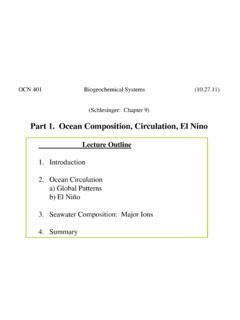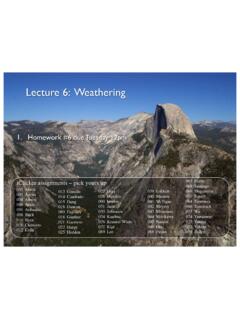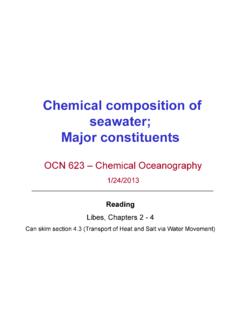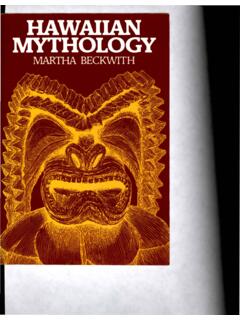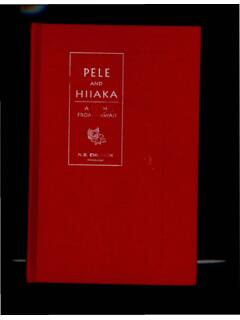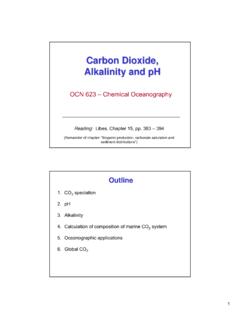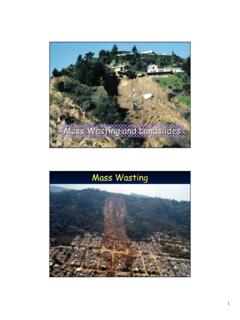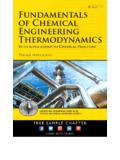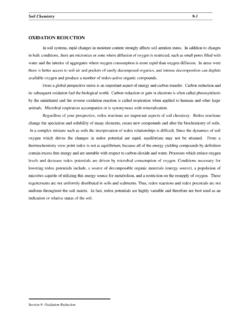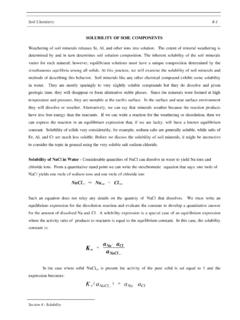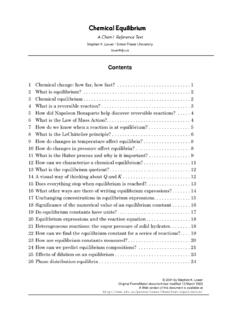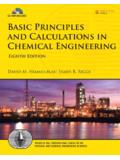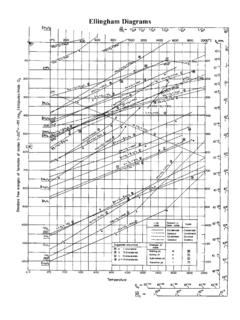Transcription of Gibbs Free Energy and Chemical Equilibrium - SOEST
1 Gibbs free Energy and Gibbs free Energy and Chemical EquilibriumChemical Equilibrium (o r how to predict Chemical reactionswithout doing experiments)OCN 623 Chemical OceanographyReading: First half of Chapter 3, Snoeyink and Jenkins (1980)IntroductionIntroduction We want to answer these questions: Will this reaction go? If so, how far can it proceed?We will do this by using thermodynamics. This lecture will be restricted to a smallsubset of thermodynamics the solution of Chemical Equilibrium problemsChemical EquilibriumChemical EquilibriumConsider a reversible reaction taking place at constant temperature:aA + bB cC + dDThe reactantsA and B combine to form productsC and concentrations of A and B decrease until they reach values that do not change with time: Note that at Equilibrium , the forward and reverse reactions proceed at the same, stable rate.
2 The time7invariant concentrations of reactants and products are called Equilibrium concentrations The ratio of these concentrations (or activities active concentrations) is characteristic for each reaction, and is called the Equilibrium constant, K:badcBADCK}{}{}{}{ free EnergyFree Energy A criterion for Equilibrium is that the total free Energy ( Gibbs free Energy , Gr)of the reaction is at a minimum: If we add more reactant or more product, the reaction will proceed spontaneously(without external help) as long as the value for Grdecreases Thus, a reaction in the direction of decreasing Gris spontaneous. A reaction in the direction of increasing Gris not spontaneous, and will not occur in a closed any reaction proceeds an incremental amount, the change in Grcan be calculated as:where iis the stoichiometric coefficient (a,b,c,d) for species i ,and Gfiis the free Energy of formation per mole of species i 1.
3 If Gr< 0, ( , Gris negative and thus Grdecreases as the reaction proceeds), then the reaction proceeds spontaneously as written2. If Gr> 0, ( , Gris positive and thus Grincreases as the reaction proceeds), then the reaction proceeds spontaneously in the opposite direction as written3. If Gr= 0, ( , Gris at a minimum), then the reaction is at Equilibrium and will not proceeds spontaneously in either directionreactantsifiiproductsifiirGGG = Values for G for a reaction give us a powerful tool to predict if a reaction is possible. We calculate in-situ Grusing this equation:whereThe the superscript zero ( ) indicates standard state: 25 C (298 K),1 atm pressure, and activity = 1 Gfi is the standard-state free Energy of formation per mole of species i { } = activity (active concentration)R = the ideal gas constant = cal K71mol71= J K71mol71T = KbadcBADCRT}{}{}{}{lnG Grr+ = In7situ Std.
4 StatereactantsifiiproductsifiirGGG = Standard free Energy of formation ( G fi): G fi= 0 at standard state for all pure elements (solid reference) G fi= 0 for H+at a concentration of 1 mole/liter at standard state (solution reference) Allows the measure of the Energy change involved in forming compounds at standard state from their component elements at standard state Measured values are listed in tables. Units are: kJ/mol (SI units) kcal/molTable in reading (handout)See complete table in handoutSample Calculation #1 Sample Calculation #1 Consider the dissolution of CaCO3(calcite) in aqueous solution:CaCO3 Ca2++ CO327 Does the reaction proceed spontaneously as written?Calculate the free Energy of reaction at standard state (products and reactants at activity = 1, P = 1 atm, T = 25 C): G r= (1(7132) + 1(7126) (1(7270)) kcal/mol= (7258 + 270) kcal/mol= +12 kcal/molreactantsifiiproductsifiirGGG = Therefore, at standard state, the reaction spontaneously proceeds in the opposite direction to what is written ( , calcite precipitates)Activities Activities How to CalculateHow to CalculateActivity of water = 1 Equilibrium at InEquilibrium at In--Situ ConditionsSitu ConditionsThus: G= G + RT ln QIn the case of Equilibrium , Q = K and G = 0:Thus: 0 = G + RT ln K G = 7RT ln KbadcBADCQ}{}{}{}{ badcBADCRT}{}{}{}{lnG G + = In7situ Std.)
5 StateWe have already seem that:We can define a reaction quotient, Q,using in7situ conditions:Substituting (for the general case): G = 7RT ln K + RT ln Q = RT ln Q/K G = RT ln Q/KThis allows us to develop a set of criteria to determine in which direction a reaction will proceed under non-standardconditions. This is because Q/K will determine the signof G:1. If Q/K < 1, then G is negative, and the reaction is spontaneous as written2. If Q/K = 1, then G = 0 and the system is at equilibrium3. If Q/K > 1, then G is positive, and the reaction is spontaneous in the opposite direction as writtenAgain consider the dissolution of CaCO3(calcite):CaCO3 Ca2++ CO327In the surface ocean, does the reaction proceed spontaneously as written?Sample Calculation #2 Sample Calculation #2 Use G = 7RT ln KFrom Sample Calculation #1, we know: G = +12 kcal/moleThus: (all units cancel out)ln K = = x 1079( Equilibrium constant )()() =Surface seawater:{CaCO3} 1[Ca2+] = mol/L; = ; {Ca2+} = [CO327] = 45 Qmol/L; = ; {CO327} = x 1076{}{}{}()() +KQQT herefore: The reaction goes in the opposite direction as written (Q/K > 1) CaCO3precipitates in the surface ocean Surface seawater is supersaturated with respect to calciteNote: No information is given on the kineticsof the reaction!
6 Temperature and Pressure EffectsTemperature and Pressure EffectsThe amount of heat that is released or taken up by a reaction iscalled the enthalpy change ( H ).Similarly to G , we can calculate H using tabulated data:where iis the stoichiometric coefficient (a,b,c,d), and H fiis the enthalpy of formation of species i(kcal/mol or kJ/mol) at standard = The van t Hoff equation gives the temperature dependence of K:For a small change in T, H does not change much, so we can integrate directly:where T* is the temperature of = = *12981ln298*TRHKKrTThe change in the partial molar volume ( V )during a reaction at standard state is also calculated using tabulated data:where iis the stoichiometric coefficient (a,b,c,d), and V fiis the partial molar volume of formation of species i(cm3/mol) at standard = The pressure dependence of Kis also known:Again integrating directly:where P* is the pressure of interest (in atm).
7 RTVPKrT = ln()1atm*ln1atm* = PRTVKKrPSee the following example in the handout for an example of temperature7correcting the Equilibrium constant:Homework Homework Due Tues 1/22/13 Due Tues 1/22/13 Problems 4, 5, 9 and 11on pages 83784 of the handout (Chapter 3 of Snoeyink and Jenkins, 1980). ReferenceReference Snoeyink, , and D. Jenkins (1980) Water Chemistry. John Wiley & Sons, New York.
